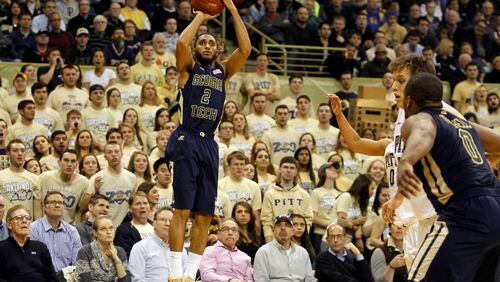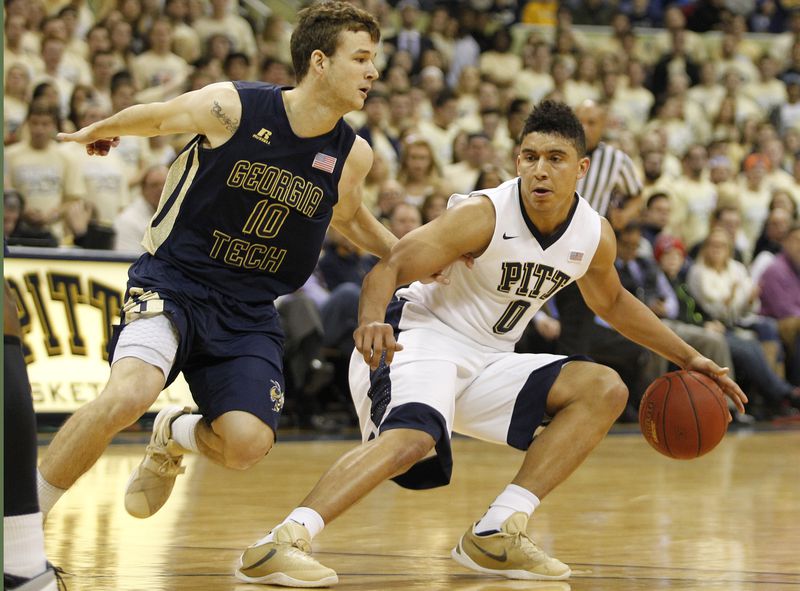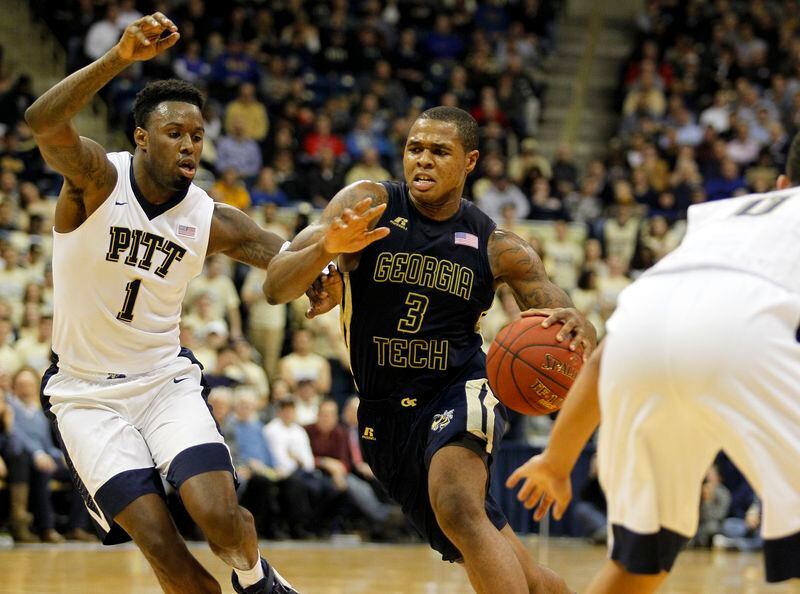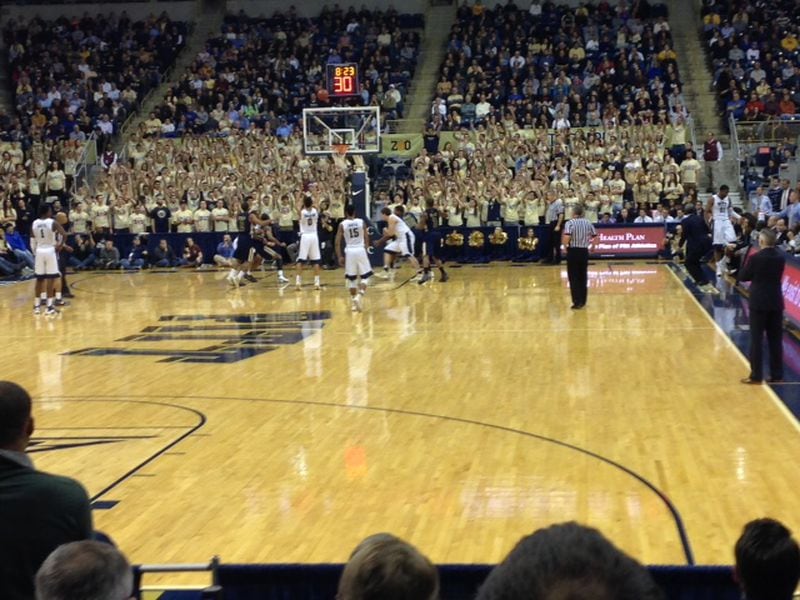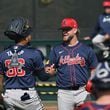Revisiting Georgia Tech's 89-84 loss to Pittsburgh Wednesday night at Petersen Events Center. (Read 5 observations from the game here.)
3 thoughts
1. Guard Adam Smith followed his 20-point game on six 3-pointers against North Carolina with a career-high 30-point game with eight 3-pointers. So I guess that means he'll score 40 points with 10 3-pointers against Virginia. He's 14-for-23 from 3-point range in his first two ACC games. Wednesday night, he kept the Yellow Jackets in the game late with back-to-back threes that cut the lead from 15 to 9 in the span of 52 seconds, the latter at 3:08.
Smith is on a remarkable tear. Going back to the Southeastern Louisiana game, he is 25-for-44 in his past five games, 56.8 percent.
It’s impressive, but the unfortunate part for Tech is that his hot shooting against North Carolina and Pittsburgh obviously didn’t lead to a win for the Yellow Jackets. Chances are pretty good that Smith will not continue to shoot 56.8 percent from 3-point range for the remainder of the season. And it may turn out to be the case that Tech could use a few clutch 3-pointers when Smith is not shooting as well.
2. So this is somewhat concerning. Prior to Wednesday, Pitt had played 26 halves of basketball. Of the 26, the Panthers had shot better than the 62.1 percent that they shot against Tech in the first half in just two of those 26 halves, against Duquesne and Maryland Eastern Shore. They had also only taken more than 24 free throws in a half (which they did in the second half against Tech) just once, also against Maryland Eastern Shore.
Nothing against Maryland Eastern Shore, but that’s probably not the company the Jackets want to be keeping defensively.
On the one hand, Tech's subpar defensive play against North Carolina this past Saturday and Pitt Wednesday could be taken as reasonable results, given how efficient both teams are on offense. North Carolina is ranked No. 2 in adjusted offensive efficiency by kenpom.com and Pitt is No. 10.
That said, these haven’t been the only two games where Tech has not played defense to Gregory’s high standards. Southeastern Louisiana shot 59.2 percent from the field in the second half. Colgate shot 48.9 percent for the game.
In the first half, Tech seemed far too lax with Pitt point guard James Robinson, who chewed the Jackets up with seven assists in the half. Defensive rotations have been a trouble spot.
“We did not play as well as needed to do on the defensive end, obviously, but they had a lot to do with that,” coach Brian Gregory said. “It’s an area we need to dramatically improve in, because we’ve dramatically improved on the offensive end, but we just did not grind out and grit out a couple key possessions there.”
It’s probably the last thing you’d expect would be said of a Gregory-coached team. It’s the most points Tech has scored in a regulation loss in Gregory’s tenure, exceeding a 93-81 loss to North Carolina in the 2011-12 season.
Speaking of efficient offenses, Tech's next opponent, Virginia, is rated No. 4 offensively by kenpom.com, and the Jackets' opponent after that, Notre Dame, is No. 5. After that is Virginia Tech (No. 131) and then Louisville (No. 19). Tech is No. 40.
Credit: Ken Sugiura
Credit: Ken Sugiura
3. What are we to make of the first two ACC games, single-digit road losses to North Carolina and Pittsburgh?
It’d be easy to conclude that nothing has changed from last season, that the Jackets continue to lose close games to ACC opponents. That may well prove an accurate observation. It’s faulty, though, at least in the regard that Tech is a much different team, as Gregory noted, in that it plays much better offense than it had in his first four seasons. (Better players and rules changes that allow more offensive movement.)
On the other hand, North Carolina rarely loses at home to anybody, and Tech played the Tar Heels far better than it had in any of the first six games that Gregory has coached. Likewise, Pitt is tough to beat at home and looks like it has the makings of a tournament team.
Played at any point of the ACC schedule, these are two games Tech would be likely to lose. It just so happens they’re the first two games, so they stand out more.
If the Jackets are going to show marked improvement, they will eventually have to pick off some of these games that they're not expected to win. I'd submit that these two are among the tougher upset attempts, but Tech obviously had it in them to stay close, which would mean they're also games the Jackets could have won with a little more.
"You go on the road in this league, you've got to play better than we've played," Gregory said.
What do the games mean? So far, it means Tech isn't as good as North Carolina and Pittsburgh and needs to play better defense.
Four factors
How Tech fared in four critical statistical categories, effective field-goal percentage (field-goal percentage that takes into account the added value of 3-pointers), turnover percentage (how frequently the teams lost possession), offensive rebound percentage (rate of offensive rebounds over all available rebounds), free-throw rate (free throws/field-goal attempts). Read more here.
Tech won two of the categories, effective field goal percentage (thanks to Smith going bananas) and offensive rebounding percentage, due to forward Charles Mitchell’s withering assault on the offensive glass (nine rebounds). However, Pitt decisively won the other two categories, which created the Panthers’ path to victory. Tech’s 14.1 turnover percentage is actually very good, but Pitt’s 5.7 percent is ridiculous.
Pitt’s ability to get to the free-throw line (and then make the free throws), coupled with the Panthers’ keeping possession, was decisive. Pitt was 25-for-3 from the free-throw line. Tech was 8-for-15. The Panthers scored on 55.7 percent of their possessions, which is a particularly high rate.
“You got to a point where, gosh, we had to score on every play,” Gregory said.
4 quotes
“We’ve got to do a better job of moving our feet and showing our hands on drives, because any time your hands are inside your shoulders on the drive, the mandate is to call a foul, which I’m fine with. I’ve got no problems with the referees. I thought they were great tonight. It’s a hard game. Two teams that play pretty physical, get the ball inside, aren’t afraid to bang a little bit, scrums on the glass. So it’s just an area we need to improve in.” – Gregory
“I just feel like it was little mental mistakes, like watching the ball, a couple backdoors, not getting that last rebound at the end of the game. That would have been crucial. It’s just effort plays and mental mistakes that lost the game.” – Mitchell
“We fought in spurts. They shot the ball really well the first half. You can give them credit, but I don’t feel like we played as well as we could have on ‘D’ the first half. We came out with a lot of energy in the beginning of the second half. We have to play like that for 40 minutes.” – Smith
“We have to basically go in and instill it in everybody’s head that it starts on the defensive end.” – forward Marcus Georges-Hunt
Credit: Ken Sugiura
Credit: Ken Sugiura
Stats to note
Smith became the first Tech player to score 30 points in a game in Gregory’s tenure.
Mitchell’s 17-rebound game is the second highest total for a Tech player in an ACC game. Three players had 18-rebound games (Alvin Jones, Gani Lawal and Derrick Favors). Four players (Jones, Lawal, Malcolm Mackey and Luke Schenscher) have had 17-rebound games.
At the game
The Oakland Zoo, the Pitt student section, circulated photocopies of Tech’s roster, complete with photos, names of family members and girlfriends along with background information to use to heckle players. It was noted that Smith, for instance, was on his third college. “Can’t decide where he wants to play” his bio read.
From my camera phone
Credit: Ken Sugiura
Credit: Ken Sugiura
Credit: Ken Sugiura
Credit: Ken Sugiura
About the Author
